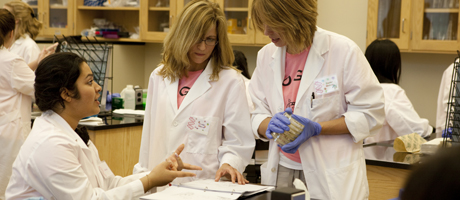By Anna Miller
When 15-year-old Logan Cromwell grows up, she wants to be a physician’s assistant. Her peer, Grace Callahan, has her sights set on being a pharmacist. And for 17-year-old Leslie Mark, who likes to “know how things work and how to fix them,” a career in surgery would be the ultimate accomplishment.
The girls — all high school students in Loudoun County Public Schools — are a few of the county’s lucky 32 students selected to attend Genomic Opportunities for Girls in Research Labs (GO GIRL), a camp on GW’s Virginia Science and Technology Campus that gives young women hands-on experience in molecular biology and genomics and exposes them to various careers in the health professions.
“GO GIRL was awesome,” said Ms. Mark, a rising senior at Dominion High School in Sterling, Va. “I had learned about some of these concepts in school, but seeing them play out in the lab really helped it all come together.”
The GO GIRL program, which launched in 2009, is supported in part by a grant from Howard Hughes Medical Institute to Loudoun County Public Schools and is run through a partnership between the George Washington University School of Medicine and Health Sciences (SMHS) and the Bernard J. Dunn School of Pharmacy at Shenandoah University. This summer, the program received additional funding from the Loudoun Education Foundation, in support of Science, Technology, Engineering and Mathematics (STEM) education.
“I think the girls walk away from the camp less intimidated by science in general,” said Nancy Skacel, assistant professor in the Department of Pharmacology and Physiology at SMHS, who founded and runs the program along with Amanda Munson and Tracey Nickola, assistant professors in Shenandoah University’s Department of Pharmacogenomics. “We try to show them that this is something that they can really do, that women can have a successful and fulfilling career as a doctor or a scientist.”
This year, the camp, which is free of charge to the students, was offered for two, four-day sessions in June. With nearly 70 applications for only 32 spots, participants were selected based on teacher recommendations and personal essays.
Like many of the campers, Ms. Mark’s favorite experiment involved manipulating bacterial DNA with florescent proteins to make them glow. Using petri dishes as canvases and bacteria as paint, they created pictures that — after growing overnight — appeared as rainbows, flowers and more when placed under ultraviolet light. The experiment demonstrated that bacteria can be transformed in the laboratory to acquire new traits.
The students practiced advanced research techniques such as DNA extraction and polymerase chain reaction. They also tested each other for a gene that is associated with the ability to taste bitter compounds in foods like brussel sprouts and cabbage.
Each day, the GO GIRL participants welcomed women from various health professions who spoke candidly about what it is like to be a woman in the field. Dubbed “lunch and learn,” this year’s guests included doctors, physician’s assistants, pharmacists and nurses.
“I came into the program expecting to do lab work, but I really enjoyed also hearing the stories of women in the health professions,” said Ms. Mark. “Seeing women who have done it before, seeing Dr. Nickola, Dr. Munson, Dr. Skacel — they’re all doctors — is very encouraging and inspirational for us when we try to move on to the next level.”
The doctors themselves say that that the female mentors in their own lives played a major role in influencing their careers as scientists. “I think we were all really lucky to have positive female role models who got us interested in the sciences and showed us that working in a lab doesn’t mean you have to be a spinster for the rest of your life,” said Dr. Nickola. “GO GIRL is kind of our way to pay it forward.”
Several female students in Shenandoah’s pharmacy school also helped out with the program and acted as mentors and friends to participants, chatting about everything from what college is really like to the difficulty of the pharmacy entrance exam to the structure and function of DNA. “We like to think that we are setting up a community of girls who are interested in science,” said Dr. Skacel. “They really bond over science and that’s cool for us to see.”
When Ms. Mark goes back to school this fall, she will conduct an independent research project and take AP physics, a course in which she may be the only female. “But that doesn’t matter,” she said. “Whether I’m the only one or there are 60 girls, I’m going to try my best. It’s your determination that drives how far you go, not your sex.”
The GO GIRL program recently attracted international attention when Drs. Skacel, Nickola and Munson presented to a delegation of six women academics, scientists and medical professionals from Benin, Burkina Faso, Gambia, Jordan and Mongolia. The group, who was invited to the U.S. by the State Department’s Bureau of Educational and Cultural Affairs, was exploring best practices in promoting the inclusion of women and girls in the fields of science and technology.
“I think this program is really impressive,” said Sherine Butros Nabih Rahil, an orthodontist from Jordan, after the June 17 presentation,. “I could definitely see something like this being very successful in my country. Can we steal the idea?”


